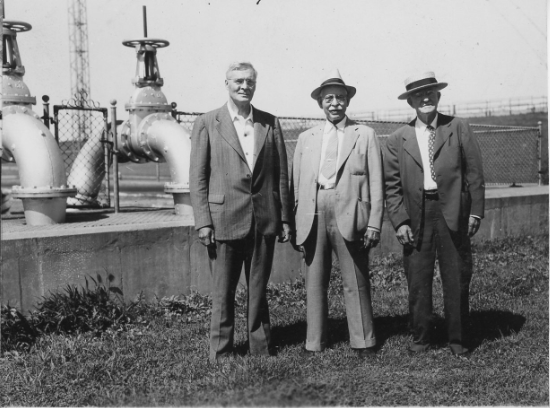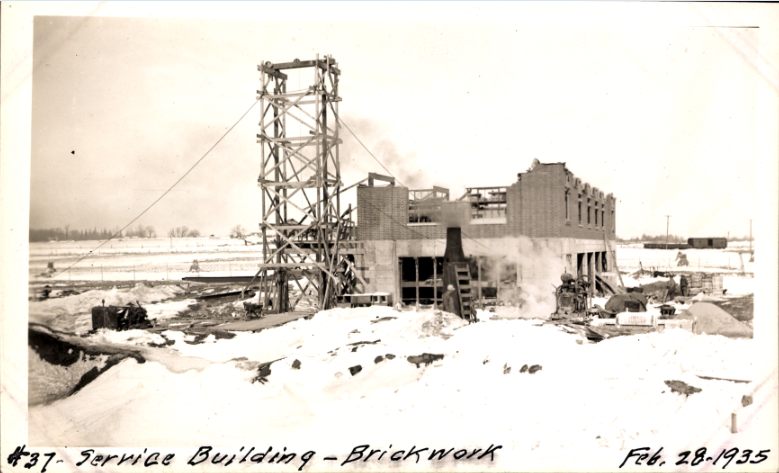What would you do if it was 1930 and you found that you had just been appointed to be a Commissioner of the newly formed Madison Metropolitan Sewerage District? You have learned that the District does not have any facilities, any employees, and has no money. This is the situation that Ernest N. Warner, Frank C. Blied, and Charles V. Seastone found themselves in when they were appointed by the Dane County Court to be the first Commissioners of the District on February 15, 1930.
The basis for creation of the District was for “the preservation of the public health, safety, comfort, convenience and welfare of the people within the District.” The Commissioners were given the authority to plan, construct, and maintain intercepting sewers to collect and transmit sewage within the District and to plan, construct and operate disposal facilities. Although the Commissioners also had authority to plan, construct, and maintain stormwater interceptors, they did not exercise this authority.
Who were these men?

Mr. Warner was an attorney who had been a member of the state legislature at one time. He was also the president of the Madison Park and Pleasure Drive Association. Warner Park is named after him. Mr. Warner was elected as the first president of the Commission.
Mr. Blied was the owner of the Blied Printing Company. He had unsuccessfully run for mayor of Madison in 1920. Mr. Blied was the first secretary of the Commission and served in that capacity for the next 18 years. Of the original Commissioners, Mr. Blied was the longest serving.
Mr. Seastone was a civil engineer who had been a professor at Purdue University and later became a well-known consulting engineer. He was a partner in the firm of Mead and Seastone at the time of his appointment to the Commission.
Unfortunately, Mr. Warner died in an automobile accident five months after being appointed. Upon Mr. Warner’s death, Mr. Seastone was elected to be the president of the Commission and served in that capacity until his death in 1940. Mr. John C. White was appointed to replace Mr. Warner. Mr. White was the State Power Plant Engineer responsible for all heating and ventilating facilities of the State of Wisconsin.
Selecting the first District employees
At the time that the District was formed, the city of Madison owned all of the sewers, pumping stations, the Burke Treatment Plant, and the Nine Springs Treatment Plant. Because City Engineer E. E. Parker was very familiar with these facilities and had supported the formation of the District, the Commissioners engaged him to serve as the Chief Engineer of the District. Mr. Parker provided this service without charge to the District.
The Commissioners also hired Herbert O. Lord, a civil engineer who had worked for the firm of Mead and Seastone. Shortly after being hired, Mr. Lord was designated as the Assistant Chief Engineer of the District. In this position, he was responsible for all of the activities of the Commission. Mr. Lord later became the Chief Engineer of the District when the sewerage facilities of the city of Madison were sold to the District.
Creating a source of revenue
How did the Commissions address the money issue? They had the authority to make special assessments and levy taxes as necessary to fund District activities. But before taxes could be levied, it was necessary to have accurate descriptions and maps of the lands within the District. This information was available for the lands within the city of Madison but had to be developed for the District lands outside of Madison. Compiling this required a significant amount of work and resulted in the creation of 370 maps.
In the fall of 1930, the Commissioners levied a one-half million tax on all property within the District. The total of this tax was $86,467.18, with the city of Madison being responsible for $75,500 of this amount. In addition, the Commission borrowed $45,000 from a local bank during the first year of operation.
Establishing the interceptor system
The city of Middleton provided the first infrastructure challenge that the Commissioners needed to address. Middleton was just completing the installation of its sewer system and had let contracts for the construction of a treatment plant. The outfall from this system was intended to be Lake Mendota. Since one of the reasons the District was formed was to prevent discharges to Lake Mendota, the Commissioners investigated how to best handle the wastewater from Middleton.
At this time the city of Madison’s sewer system extended only as far west as the intersection of University Avenue and Farley Avenue. Engineers for the District determined that an interceptor could be laid from this point to the outfall of the Middleton sewers. Recognizing that this construction would take some time, the Commissioners decided to construct a temporary treatment plant in Middleton to handle the wastewater while the interceptor system was being built. The plant was basically a septic tank with chlorination of the effluent prior to discharge to the lake. This system cost $2,649.35.

Control of treatment plants and other future goals
The first Annual Report of the Commissioners ends with a description of their plans for the future. Since wastewater from other municipal entities would eventually be treated by the existing treatment plants, the Commissioners felt that the treatment plants should be transferred to the District. Although the Commissioners were optimistic that this could be done, resistance to this idea formed within some sectors of the city and the transfer did not happen until 1933.
The Commissioners also desired that the wastewater from the Soldiers’ Memorial Hospital and the State Hospital for the Insane, which was being treated “indifferently” before being discharged to Lake Mendota, be transmitted to one of the Madison treatment plants. They were in negotiations with officials at the State to make this happen. In addition, the Commissioners had authorized topographic surveys to be done on the lands on the east and southeast sides of Lake Monona as well as in the towns of Westport and Burke to determine how to best serve these areas in the future.
For the next ten busy years, these three Commissioners guided the District through the construction of intercepting sewers in the rapidly growing areas of the District, the expansion of the Nine Springs Treatment Plant, and the closing of the Burke Treatment Plant all the while responding to the political and policy challenges facing this new entity.
Visit the History section of our blog for additional articles in the series, as well as “Flow of history…” articles documenting the early years of wastewater treatment in the Madison area.
Written by Paul Nehm






